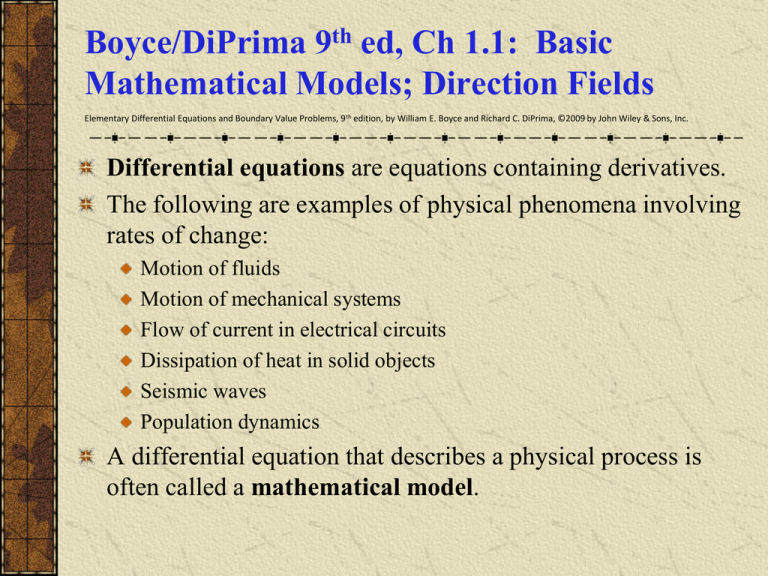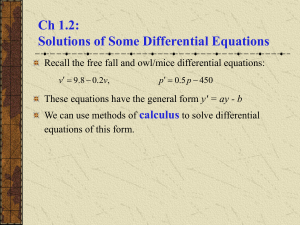Math 240: Transition to Advanced Math
advertisement

Boyce/DiPrima 9th ed, Ch 1.1: Basic Mathematical Models; Direction Fields Elementary Differential Equations and Boundary Value Problems, 9th edition, by William E. Boyce and Richard C. DiPrima, ©2009 by John Wiley & Sons, Inc. Differential equations are equations containing derivatives. The following are examples of physical phenomena involving rates of change: Motion of fluids Motion of mechanical systems Flow of current in electrical circuits Dissipation of heat in solid objects Seismic waves Population dynamics A differential equation that describes a physical process is often called a mathematical model. Example 1: Free Fall Formulate a differential equation describing motion of an object falling in the atmosphere near sea level. Variables: time t, velocity v Newton’s 2nd Law: F = ma = m(dv/dt) net force Force of gravity: F = mg downward force Force of air resistance: F = v upward force Then dv m mg v dt Taking g = 9.8 m/sec2, m = 10 kg, = 2 kg/sec, we obtain dv dt 9.8 0.2v v 9.8 0.2v Example 2: Sketching Direction Field (1 of 3) Using differential equation and table, plot slopes (estimates) on axes below. The resulting graph is called a direction field. (Note that values of v do not depend on t.) v 0 5 10 15 20 25 30 35 40 45 50 55 60 v' 9.8 8.8 7.8 6.8 5.8 4.8 3.8 2.8 1.8 0.8 -0.2 -1.2 -2.2 Example 2: Direction Field Using Maple (2 of 3) v 9.8 0.2v Sample Maple commands for graphing a direction field: with(DEtools): DEplot(diff(v(t),t)=9.8-v(t)/5,v(t), t=0..10,v=0..80,stepsize=.1,color=blue); When graphing direction fields, be sure to use an appropriate window, in order to display all equilibrium solutions and relevant solution behavior. v 9.8 0.2v Example 2: Direction Field & Equilibrium Solution (3 of 3) Arrows give tangent lines to solution curves, and indicate where soln is increasing & decreasing (and by how much). Horizontal solution curves are called equilibrium solutions. Use the graph below to solve for equilibrium solution, and then determine analytically by setting v' = 0. Set v 0 : 9.8 0.2v 0 9.8 v 0.2 v 49 Equilibrium Solutions In general, for a differential equation of the form y ay b, find equilibrium solutions by setting y' = 0 and solving for y : y (t ) b a Example: Find the equilibrium solutions of the following. y 2 y y 5 y 3 y y ( y 2) Example 3: Mice and Owls (1 of 2) Consider a mouse population that reproduces at a rate proportional to the current population, with a rate constant equal to 0.5 mice/month (assuming no owls present). When owls are present, they eat the mice. Suppose that the owls eat 15 per day (average). Write a differential equation describing mouse population in the presence of owls. (Assume that there are 30 days in a month.) Solution: dp 0.5 p 450 dt Example 5: Direction Field (2 of 2) Discuss solution curve behavior, and find equilibrium soln. p 0.5 p 450 Steps in Constructing Mathematical Models Using Differential Equations Identify independent and dependent variables and assign letters to represent them. Choose the units of measure for each variable. Articulate the basic principle that underlies or governs the problem you are investigating. This requires your being familiar with the field in which the problem originates. Express the principle or law in the previous step in terms of the variables identified at the start. This may involve the use of intermediate variables related to the primary variables. Make sure each term of your equation has the same physical units. The result may involve one or more differential equations.







